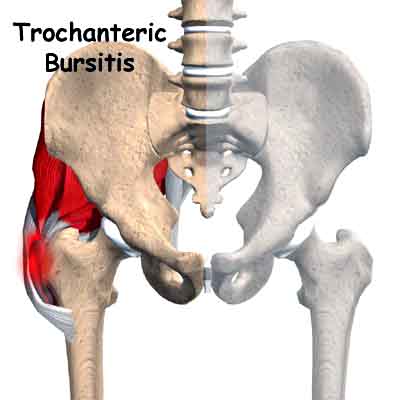Trochanteric Bursitis – A Common Cause of Hip Pain
 Hip pain is a common symptom that many patients suffer from. While conditions such as arthritic hip joints and hip strains are common, trochanteric bursitis is a common cause of hip pain that is frequently overlooked. The trochanter bursa overlies the outer portion of the hip joint, basically on the side of the upper thigh – hip area. The greater trochanter is the protuberance on the upper part of the femur, the large leg bone that fits into the hip joint. A tendon passes over the trochanter, with a bursa lying just underneath it. When this bursa becomes inflamed, it is known as bursitis. Trochanteric bursitis is most common in older individuals but may be seen in younger patients who engage in strenuous physical exercise such as running, jogging, racquet sports or long distance biking.
Hip pain is a common symptom that many patients suffer from. While conditions such as arthritic hip joints and hip strains are common, trochanteric bursitis is a common cause of hip pain that is frequently overlooked. The trochanter bursa overlies the outer portion of the hip joint, basically on the side of the upper thigh – hip area. The greater trochanter is the protuberance on the upper part of the femur, the large leg bone that fits into the hip joint. A tendon passes over the trochanter, with a bursa lying just underneath it. When this bursa becomes inflamed, it is known as bursitis. Trochanteric bursitis is most common in older individuals but may be seen in younger patients who engage in strenuous physical exercise such as running, jogging, racquet sports or long distance biking.
Diagnosis of this condition is straightforward. Typically the history is one of trauma to the hip or a gradual onset of hip pain. As the pain worsens, it can radiate done the side of the thigh or into the buttocks region, causing leg pain (sciatica). Your doctor will perform a detailed history and physical exam. Different leg movements will be tested to see what triggers the pain. X-rays frequently will be performed to make sure there are no other problems such as arthritis or small fractures (hairline fractures) in the hip. Once the diagnosis is confirmed, appropriate treatment can be started.
.jpg)
Treatment starts with stopping the activity that is worsening the pain. Anti-inflammatory medication in combination with stretching the hip and back will improve recovery time. For patients with more severe pain, a steroid injection with local anesthetic can frequently provide relief. Ice packs or sometime moist heat will provide symptomatic relief. Physical therapy is frequently beneficial in assisting the patient with hip stretching and strengthening. Core body rehabilitation is beneficial for not only the hips the back and legs as well. Attention must be pain to the iliotibial band. This is a band of fibrous tissue that extends from the lateral hip diagonally down the outer thigh to the knee. This band of tissue frequently becomes excessively tight and inflamed, resulting in more leg pain. This inflammation can mimic sciatic pain and if not recognized and treated, will continue to cause the patient pain.
.jpg) For patients that are not responding to more conservative measures, platelet rich plasma therapy is an ideal therapy for providing patients with a very good chance of pain relief and healing. The PRP graft is put directly into the trochanteric bursa or along the iliotibial band. With the concentrated healing components of the blood being put directly in the damaged tissue, healing is magnified and accelerated. The activated platelets release bioactive proteins that recruit the other tissue regeneration components such as fibrinocytes which lay down new collagen to repair the damaged tissue. Angiogenesis (new blood vessel formation) is stimulated, bringing more blood into an area that already does not have a good blood supply. Additional cells come in, including stem cells which can then differentiate into the type of tissue that is being repaired or regenerated. The entire process takes 6 weeks for complete healing. Depending on the degree of injury a second treatment at 4 weeks may be necessary. If you have persistent hip or thigh pain, which has not responded to “standard” therapies, PRP may be for you. Ask your doctor if PRP is right for you. Contact Sarasota Neurology for consultation to determine if platelet rich plasma will help.
For patients that are not responding to more conservative measures, platelet rich plasma therapy is an ideal therapy for providing patients with a very good chance of pain relief and healing. The PRP graft is put directly into the trochanteric bursa or along the iliotibial band. With the concentrated healing components of the blood being put directly in the damaged tissue, healing is magnified and accelerated. The activated platelets release bioactive proteins that recruit the other tissue regeneration components such as fibrinocytes which lay down new collagen to repair the damaged tissue. Angiogenesis (new blood vessel formation) is stimulated, bringing more blood into an area that already does not have a good blood supply. Additional cells come in, including stem cells which can then differentiate into the type of tissue that is being repaired or regenerated. The entire process takes 6 weeks for complete healing. Depending on the degree of injury a second treatment at 4 weeks may be necessary. If you have persistent hip or thigh pain, which has not responded to “standard” therapies, PRP may be for you. Ask your doctor if PRP is right for you. Contact Sarasota Neurology for consultation to determine if platelet rich plasma will help.
